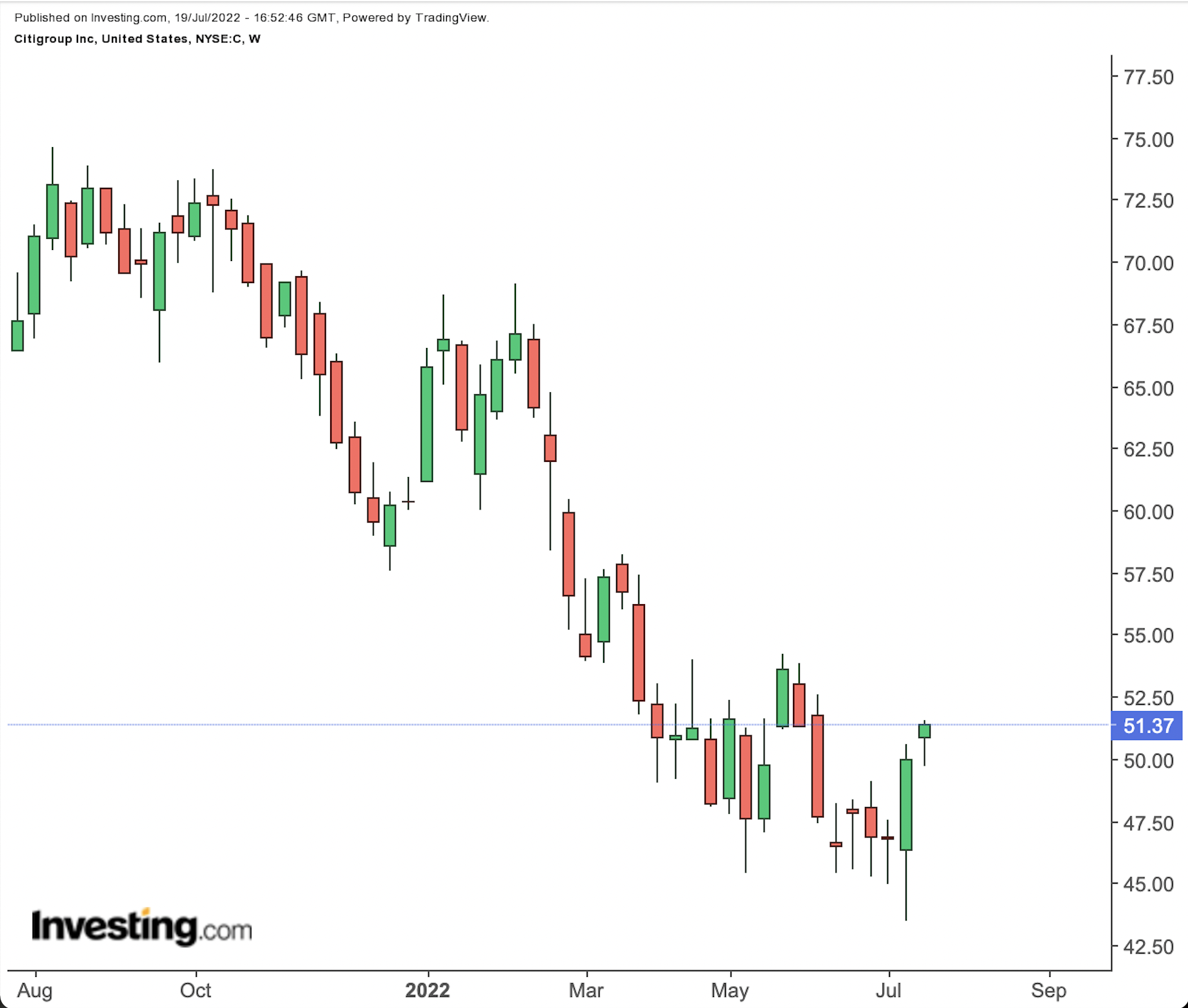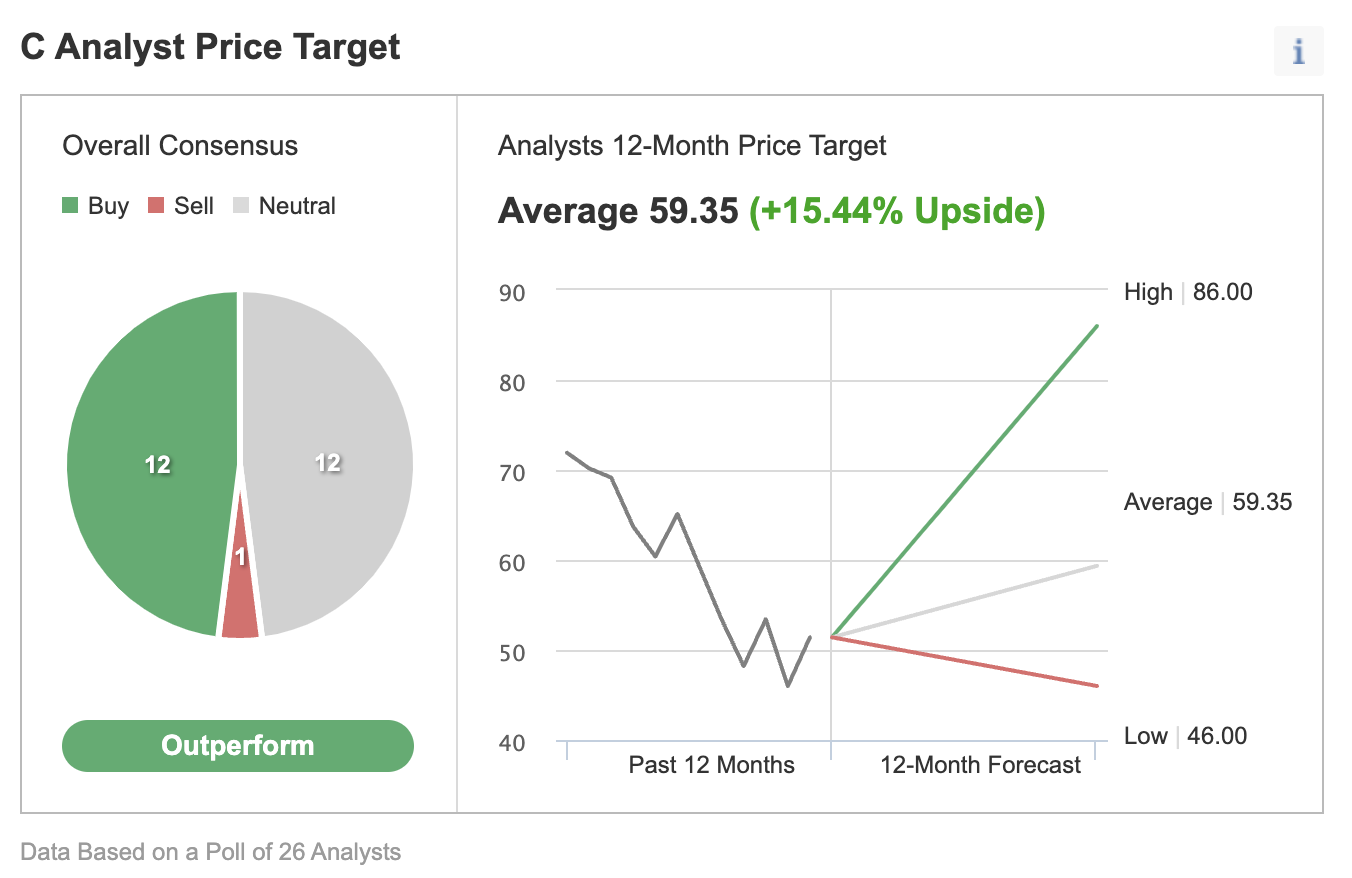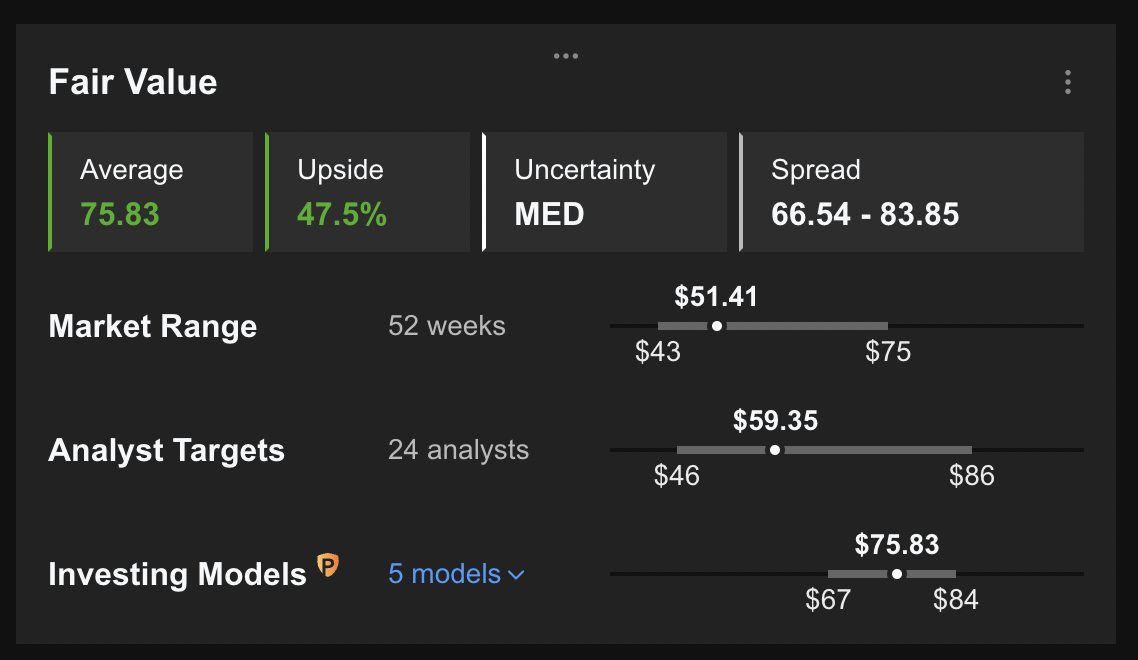- Shares of Citigroup are down more than 15% since the start of 2022
- Recent quarterly metrics benefiting from rising interest rates, robust trading results
- Long-term investors could consider investing in C stock which supports a dividend yield of 3.96%.
Shareholders in the banking giant Citigroup (NYSE:C) have seen the value of their investment drop by more than 22.7% over the past 12 months and about 15% so far this year. By comparison, the KBW Nasdaq Bank Index as well as Wall Street’s most prominent benchmark, the S&P 500 Index, are down roughly 19.7% and 18.1% so far this year.

Source: Investing.com
On Aug.12, 2021, C shares went over $74. However, shares have plunged to $43.5 on July 14—a multi-year low. The stock’s 52-week range has been $43.44 - $74.64, while the market capitalization currently stands at $99.3 billion.
Metrics by the Federal Reserve highlight that among domestic banks, Citibank is number four by consolidated assets. The top spot belongs to JPMorgan Chase (NYSE:JPM).
Recent Metrics
Citigroup released Q2 financials on July 15. Revenue increased 11% year-over-year to $19.6 billion, driven by growth in both net interest income as well as non-interest revenue. However, net income fell 23% YoY to $2.19 per diluted share, down from $2.85 per diluted share a year ago. The decline was primarily due to higher cost of credit and rising expenses.
At quarter end, Citigroup’s CET1 Capital ratio was 11.9%, up from 11.4% in the prior quarter. The Fed has “a minimum CET1 capital requirement of 4.5%, which is the same for each bank.”
Citigroup's largest revenue generator, the Institutional Clients Group, reported revenue of more than $11.4 billion, up 20% YoY. The Treasury and Trade Solutions (TTS) group within this unit generated more than $3 billion of revenue, growing 33% YoY.
On the results, CEO Jane Fraser stated:
“We ended the quarter with a Common Equity Tier 1 ratio of 11.9%, having built capital due to a higher regulatory requirement. We intend to generate significant capital for our investors, given our earnings power and the upcoming divestitures.”
During the quarter, the board returned a total of $1.3 billion to shareholders in the form of dividends and repurchases. Meanwhile, C stock currently generates an attractive yield of 3.96%.
After the release of Q2 results, Citigroup maintained 2022 guidance for revenue and expenses. As a reminder, the bank forecasts full-year revenues to increase in the low single-digit range. Management expects expenses to grow by 7% to 8%, excluding the impact of divestitures.
Prior to the release of Q2 results, C stock was changing hands at around $44. At the time of writing, it is at $51.3.
What To Expect From Citigroup Stock
Among 26 analysts polled via Investing.com, C stock has an "outperform" rating. Wall Street has a 12-month median price target of $59.35 for the stock, implying an increase of about 15.5% from the current price. The 12-month price range currently stands between $46 and $86.

Source: Investing.com
Similarly, according to a number of valuation models, like those that might consider P/E or P/S multiples or terminal values, the average fair value for Citigroup stock on InvestingPro stands at $75.83.

Source: InvestingPro
In other words, fundamental valuation suggests shares could increase by close to 48%.
At present, P/E, P/B and P/S ratios for Citigroup stock are 6.3x, 0.6x and 1.4x, respectively. Comparable metrics in the financials sector stand at 8.2x, 1.0x and 2.6x, respectively. These numbers suggest that the fundamental valuation for C stock looks significantly undervalued.
Our expectation is for Citigroup stock to trade in a wide range between $48 and $54 to build a base in the coming weeks. Afterwards, C shares could potentially start a new leg up.
Adding C Stock To Portfolios
Citigroup bulls who are not concerned about short-term volatility could consider investing now. Their target price would be $59.35, as per the target provided by analysts.
Alternatively, investors could consider buying an exchange-traded fund (ETF) that has C stock as a holding. Examples include:
- Invesco KBW Bank ETF (NASDAQ:KBWB)
- First Trust Nasdaq Bank ETF (NASDAQ:FTXO)
- Invesco S&P 500® Enhanced Value ETF (NYSE:SPVU)
- iShares U.S. Financial Services ETF (NYSE:IYG)
Finally, investors who expect C stock to bounce back in the weeks ahead could consider setting up a covered call.
Most option strategies are not suitable for all retail investors. Therefore, the following discussion on C stock is offered for educational purposes and not as an actual strategy to be followed by the average retail investor.
Covered Call On C Stock
Intraday Price At Time Of Writing: $51.30
For every 100 shares held, the strategy requires the trader to sell one call option with an expiration date at some time in the future.
A stock option contract on C (or any other stock) is the option to buy (or sell) 100 shares.
Investors who believe there could be short-term profit-taking soon might use a slightly in-the-money (ITM) covered call. A call option is ITM if the market price (here, $51.30) is above the strike price ($50).
So, the investor would buy (or already own) 100 shares of C stock at $51.30 and, at the same time, sell a Citigroup Oct. 21 $50-strike call option. This option is currently offered at a price (or premium) of $4.10.
An option buyer would have to pay $4.10 X 100 (or $410) in premium to the option seller. This call option will stop trading on Friday, Oct. 21.
This premium amount belongs to the option writer (seller) no matter what happens on the day of expiry.
The $50-strike offers more downside protection than an at-the-money (ATM) or out-of-the-money (OTM) call.
Assuming a trader would now enter this covered call trade at $50, at expiration, the maximum return would be $280, i.e., ($410 - ($51.30 - $50.00) X 100), excluding trading commissions and costs.
On expiration day, if the stock closes below the strike price, the option would not get exercised, but would instead expire worthless. Then, the stock owner with the covered call position gets to keep the stock and the money (premium) s/he was paid for selling the option.
At expiration, this trade would break even at a C stock price of $47.20, excluding trading commissions and costs.
Another way to think of this break-even price is to subtract the call option premium ($4.10) from the underlying C stock price when we initiated the covered call (i.e., $51.30).
On Oct. 21, if C stock closes below $47.20, the trade would start losing money within this covered call setup. Therefore, by selling the covered call, the investor has some protection against a potential loss in the case of a decline in the underlying shares. In theory, a stock's price could drop to $0.
Bottom Line
The exact market-timing of when C stock could take a breather is difficult to determine, even for professional traders. But options strategies provide tools that might prepare for sideways moves or even drops in the price of Citigroup shares, especially following the earnings release.
We regard covered call options as a potential way to earn additional income from your stock portfolio. Such a strategy also helps lower portfolio volatility. Interested investors might consider increasing their knowledge base.
Disclaimer: On the date of publication, Tezcan Gecgil, Ph.D., did not have any positions in the securities mentioned in this article.
